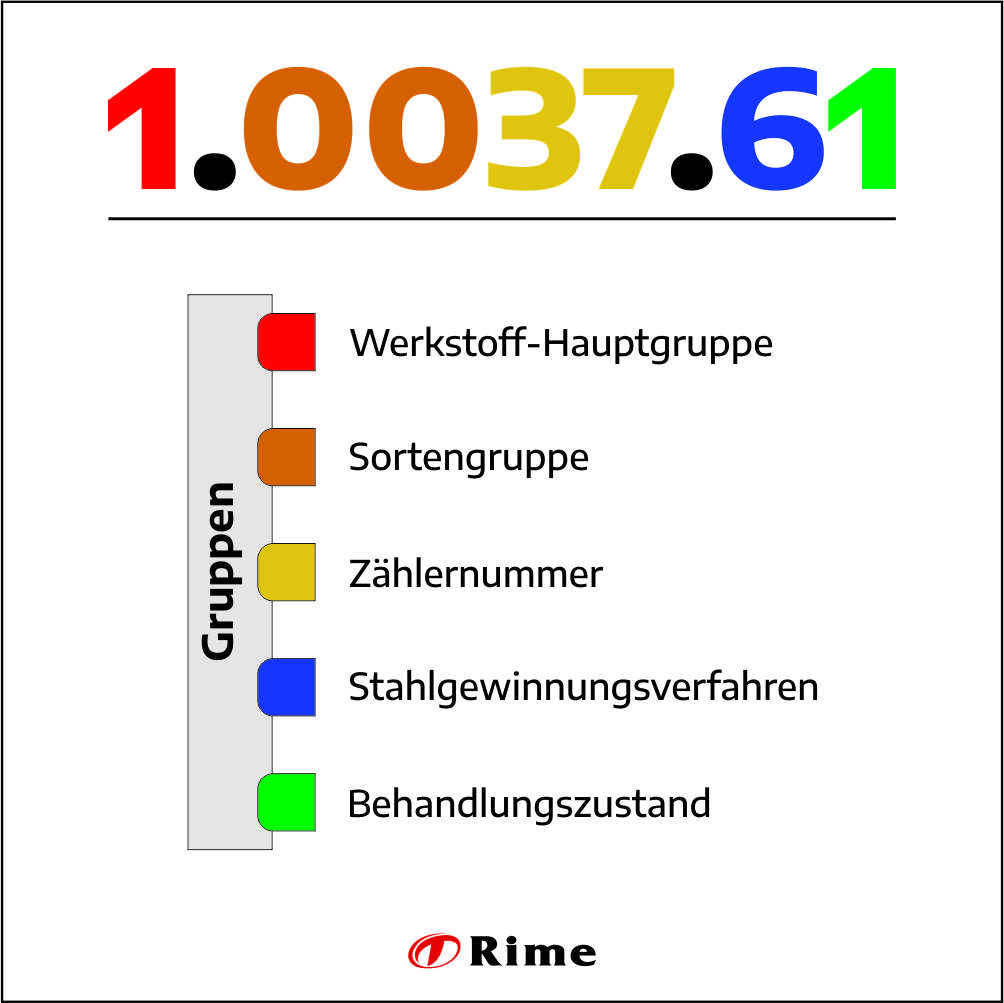Material numbers
With the introduction of material numbers, a practical system was developed for uniquely defining different materials. A material number consists of 7 digits, which are in turn divided into 5 groups.
Main material group
The first digit contains the principal material group and indicates the material involved. Rime is specialised in the machining of metal sheets and plates made of steel, stainless or rustproof steel and aluminium. For this reason, the principal material groups 1 and 3 are mainly important to use.
The principal group 1 unites all materials that are made of steel or cast steel. The third principal group contains the lightweight metals which include, among other things, aluminium and titanium.
Steel group / grade class
The next two numbers together form the steel group of the principal material group or the grade number of the remaining principal groups. These figures provide additional information such as the carbon content or whether it involves grades such as mild steel, pressure vessel steel, tool steel or roller bearing steel. There are also steel group numbers for steel grades with special properties such as heat and rust resistance, resistance to chemical substances or magnetic properties.
In the case of the principal material groups 2 and 3 the grade number is used to subdivide the materials into non-ferrous base metals such as copper, zinc, cadmium, lead, aluminium, magnesium, titanium and precious metals.
Count number
The next two numbers are count numbers (serial numbers), in order to differentiate between materials which belong to the same steel group or in the case of non-ferrous materials, which have the same grade number. But they do not provide any information whatsoever about the composition of the material.
Steel production method / temper group
Only 10 production methods exist in total, which are as follows:
Steel
The 6th digit of a material number of principal group 1 provides information about the steel production method used.
- 0 – not defined or not significant
- 1 – unkilled Thomas steel (basic Bessemer steel)
- 2 – killed Thomas steel
- 3 – other smelting process, unkilled
- 4 – other smelting process, killed
- 5 – unkilled Siemens-Martin steel
- 6 – killed Siemens-Martin steel
- 7 – unkilled basic oxygen steel (top-blown steel)
- 8 – killed basic oxygen steel (top-blown steel)
- 9 – electric-furnace steel (electric steel)
Non-ferrous materials
If the material is non-ferrous, the 6th digit is designated as a temper group. These are then as follows:
- 0 – untempered
- 1 – soft annealed
- 2 – cold work-hardened (intermediate hardening)
- 3 – cold work-hardened
- 4 – without mechanical finishing, solution annealed
- 5 – solution annealed, cold finished
- 6 – without mechanical finishing, artificially aged
- 7 – artificially aged, cold finished
- 8 – without previous cold work-hardening, stress relieved
- 9 – special treatment
Heat treatment condition
The final digit denotes the heat treatment condition (temper designation). The ten heat treatment conditions are as follows:
- 0 – untempered
- 1 – normalised
- 2 – soft annealed
- 3 – heat treated
- 4 – toughened-quenched and tempered
- 5 – quenched and tempered
- 6 – hard-quenched and tempered
- 7 – cold work-hardened
- 8 – spring-tempered cold work-hardened
- 9 – treated to special specifications
Taking the information given above into account, the material number 1.0037.61 given in the figure above is a normalised, killed Siemens-Martin steel.
See also
Brinell hardness test
Performing the hardness test by means of a ball pressure test according to the Swedish engineer Johann August Brinell.
Read moreCoil
Plate metal that is rolled-up to coils is easier to transport and requires less space in the warehouse
Read moreCorrosion
Corrosion is a natural process and damages most metals. What types of corrosion are there?
Read more